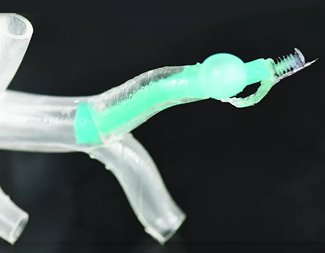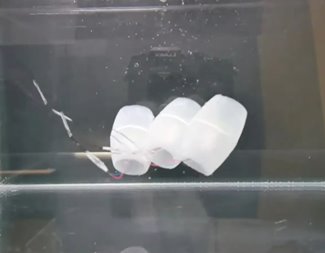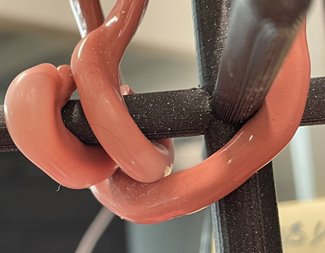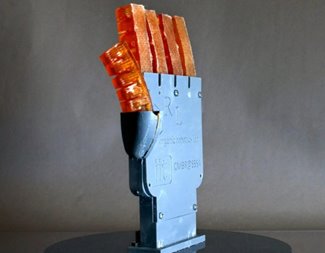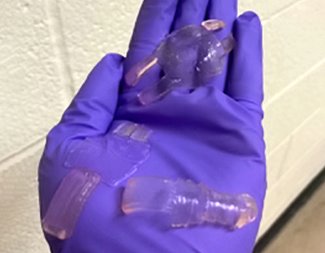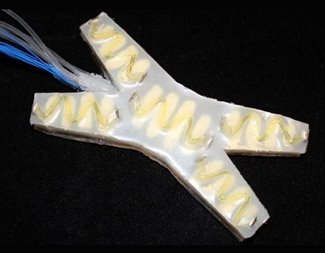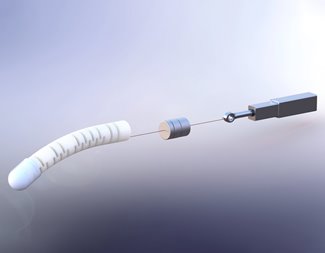7 Soft Designs that are Reimagining Robotics
7 Soft Designs that are Reimagining Robotics
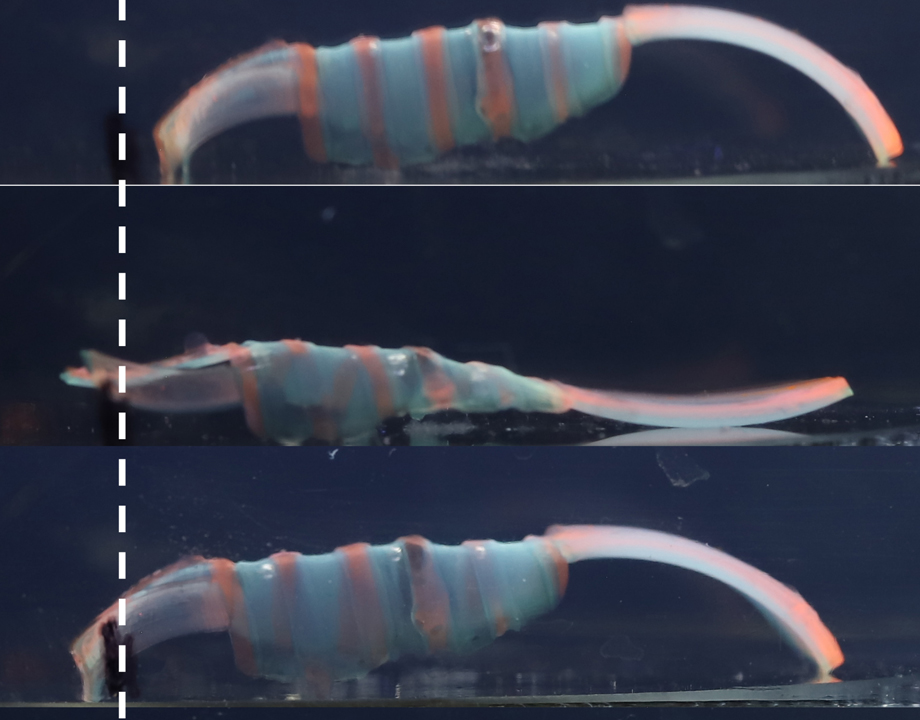

Worm-like robot is just one of many innovative designs.
Soft robots offer a new level of control and sensitivity that rigid bots do not typically have. With their flexible and often delicate parts, soft robots are on the cusp of mechanizing and mimicking many of Earth’s living creatures for advances in medicine, manufacturing, space observation, and deep-sea exploration.
Here are some of the innovative designs that are changing the way we think about robotics.
1. This robot can travel through the lungs
With multiple degrees of freedom and three separate actuators, this flexible soft robot can travel through a person’s lungs. Once it stabilizes itself, the actuators allow the bot to apply enough force to take a biopsy of nearby tumors, using a small needle at its end.
“An advantage of using soft materials is that we can exploit the fact that the robot can safely interact with biological tissue to anchor the robot within the lung branches,” said Sheila Russo, whose team developed this project at Boston University.
This advance means biopsies of lung tumors will be less invasive than with traditional methods, providing a safer and more efficient alternative for the patient.
2. Tiny “RoboSalps” could explore Europa’s underwater depths
A team of engineers at the University of Bristol have mimicked a type of zooplankton known as salps with their latest design of “RoboSalps.” Salps are known for forming large chains in the ocean when spawning. Like their living counterparts, RoboSalps also form a chain. Using tiny individual motors, some of the salps in the chain may move vertically, while others traverse the water horizontally, which makes the chain appear to float or suspend in the water. This formation makes it easier for the bots to travel to their destinations, where they can then split apart and complete their underwater tasks. The team is hopeful that they will one day be used on an extraterrestrial mission to Jupiter’s moon, Europa.
3. These tentacle robots are great for gripping delicate objects
The one downfall of many soft robotic advances is that many have little to no internal strength, making it difficult to imagine applications where they may be able to lift, push, or pull anything other than their own form. By using a clever pressurizing technique, a team at the Harvard John A. Paulson School of Engineering and Applied Sciences was able to develop a soft robot that mimics the tentacles of an octopus.
Become a Member: How to Join ASME
On their own, the tentacles can’t do much, but when they are pressurized and begin to intertwine around an object, they become strong enough to lift and hold it safely. The tentacles proved effective at gripping soft fruits, houseplants, and irregular-shaped objects like glassware. “By taking advantage of the natural compliance of soft robotics and enhancing it with a compliant structure, we designed a gripper that is greater than the sum of its parts and a grasping strategy that can adapt to a range of complex objects with minimal planning and perception,” said Kaitlyn Becker, an assistant mechanical engineering professor.
4. This robot “sweats” to prevent overheating
Microwaves, vacuums, and hair straighteners can all overheat, causing severe malfunction and even a complete breakdown of circuitry. Preventing a robotic system from overheating is critical for robots that are assigned tasks that are energy or time intensive. This common pitfall in machinery inspired a team of engineers at Cornell University to design a soft robot that “sweats.”
Like humans, the bot is able to secrete water, which then evaporates from its surface, removing excess heat and cooling off the system. Because the robot is covered in a soft skin-like hydrogel, the water does not jeopardize the system in any way. Testing of this bot’s sweating abilities showed that it had a cooling capacity of 107 watts per kilogram, more than three times that of humans.
This natural solution to overheating means the bot is able to stay cooler for longer periods of time and endure hotter work environments.
5. This worm-like bot can wiggle when the temperature changes
Another benefit of soft robots is their lightweight frames can respond to environmental stimuli like pressure, magnetism, and temperature. This offers possibilities for bots that aren’t controlled by any motors, batteries, or electrical components.
More for You: Liquifying Robot Points to Shape-Shifting Electronics
A team at Johns Hopkins University built on these principals by creating a worm-like soft robot that expands and contracts in response to temperature shifts. They envision a whole lineup of “gelbots” that can be trained to respond to human biomarkers or biochemicals.
Although they may only be able to travel in one direction, these simple motions could prove useful for applications in medicine, especially because the bot could safely dissolve in the human body once it completes its task.
6. This robot can heal itself
Like all things, living or not, soft robots can experience wear and tear over time. But a robot that can “heal” itself would not only last longer on the job, but would mean that humans do not have to interfere for repairs, making it ideal for tasks in hard-to-reach environments.
A team of researchers at Cornell University have set out to create a robotic “skin” that can detect where it is damaged and then heal the area. The elastic skin consists of fiberoptic sensors that produce LED light. An optical waveguide then inspects the light to gauge deformities. When damage is found, the hydrogen bonds in the elastic material are able to rejoin.
To test the self-healing capabilities, the skin was installed on a starfish-like robot and was punctured in one of its arms. It immediately detected the puncture and healed over in about a minute. Although not fully indestructible, this skin extends the life expectancy of possible soft robot designs in the future.
7. This robot has a sense of touch
Another promising area of interest for soft robotics is the application of human-like senses. Robots that can smell, taste, and touch are being developed for a range of applications. In particular, a team at Beihang University in Beijing have developed a humanoid finger that combines a tactile sense of touch along with a strain sensor to recreate proprioception, which gives the robot not only a sense of what it’s touching, but also a sense of itself. It then uses machine learning to determine the texture and rigidity of the object with which it is interacting.
The design may prove effective for robotic prosthetics in the future, giving users an even more realistic experience when touching something.
Cassandra Martindell is an independent writer in Columbus, Ohio.
Here are some of the innovative designs that are changing the way we think about robotics.
1. This robot can travel through the lungs
With multiple degrees of freedom and three separate actuators, this flexible soft robot can travel through a person’s lungs. Once it stabilizes itself, the actuators allow the bot to apply enough force to take a biopsy of nearby tumors, using a small needle at its end.
“An advantage of using soft materials is that we can exploit the fact that the robot can safely interact with biological tissue to anchor the robot within the lung branches,” said Sheila Russo, whose team developed this project at Boston University.
This advance means biopsies of lung tumors will be less invasive than with traditional methods, providing a safer and more efficient alternative for the patient.
2. Tiny “RoboSalps” could explore Europa’s underwater depths
A team of engineers at the University of Bristol have mimicked a type of zooplankton known as salps with their latest design of “RoboSalps.” Salps are known for forming large chains in the ocean when spawning. Like their living counterparts, RoboSalps also form a chain. Using tiny individual motors, some of the salps in the chain may move vertically, while others traverse the water horizontally, which makes the chain appear to float or suspend in the water. This formation makes it easier for the bots to travel to their destinations, where they can then split apart and complete their underwater tasks. The team is hopeful that they will one day be used on an extraterrestrial mission to Jupiter’s moon, Europa.
3. These tentacle robots are great for gripping delicate objects
The one downfall of many soft robotic advances is that many have little to no internal strength, making it difficult to imagine applications where they may be able to lift, push, or pull anything other than their own form. By using a clever pressurizing technique, a team at the Harvard John A. Paulson School of Engineering and Applied Sciences was able to develop a soft robot that mimics the tentacles of an octopus.
Become a Member: How to Join ASME
On their own, the tentacles can’t do much, but when they are pressurized and begin to intertwine around an object, they become strong enough to lift and hold it safely. The tentacles proved effective at gripping soft fruits, houseplants, and irregular-shaped objects like glassware. “By taking advantage of the natural compliance of soft robotics and enhancing it with a compliant structure, we designed a gripper that is greater than the sum of its parts and a grasping strategy that can adapt to a range of complex objects with minimal planning and perception,” said Kaitlyn Becker, an assistant mechanical engineering professor.
4. This robot “sweats” to prevent overheating
Microwaves, vacuums, and hair straighteners can all overheat, causing severe malfunction and even a complete breakdown of circuitry. Preventing a robotic system from overheating is critical for robots that are assigned tasks that are energy or time intensive. This common pitfall in machinery inspired a team of engineers at Cornell University to design a soft robot that “sweats.”
Like humans, the bot is able to secrete water, which then evaporates from its surface, removing excess heat and cooling off the system. Because the robot is covered in a soft skin-like hydrogel, the water does not jeopardize the system in any way. Testing of this bot’s sweating abilities showed that it had a cooling capacity of 107 watts per kilogram, more than three times that of humans.
This natural solution to overheating means the bot is able to stay cooler for longer periods of time and endure hotter work environments.
5. This worm-like bot can wiggle when the temperature changes
Another benefit of soft robots is their lightweight frames can respond to environmental stimuli like pressure, magnetism, and temperature. This offers possibilities for bots that aren’t controlled by any motors, batteries, or electrical components.
More for You: Liquifying Robot Points to Shape-Shifting Electronics
A team at Johns Hopkins University built on these principals by creating a worm-like soft robot that expands and contracts in response to temperature shifts. They envision a whole lineup of “gelbots” that can be trained to respond to human biomarkers or biochemicals.
Although they may only be able to travel in one direction, these simple motions could prove useful for applications in medicine, especially because the bot could safely dissolve in the human body once it completes its task.
6. This robot can heal itself
Like all things, living or not, soft robots can experience wear and tear over time. But a robot that can “heal” itself would not only last longer on the job, but would mean that humans do not have to interfere for repairs, making it ideal for tasks in hard-to-reach environments.
A team of researchers at Cornell University have set out to create a robotic “skin” that can detect where it is damaged and then heal the area. The elastic skin consists of fiberoptic sensors that produce LED light. An optical waveguide then inspects the light to gauge deformities. When damage is found, the hydrogen bonds in the elastic material are able to rejoin.
To test the self-healing capabilities, the skin was installed on a starfish-like robot and was punctured in one of its arms. It immediately detected the puncture and healed over in about a minute. Although not fully indestructible, this skin extends the life expectancy of possible soft robot designs in the future.
7. This robot has a sense of touch
Another promising area of interest for soft robotics is the application of human-like senses. Robots that can smell, taste, and touch are being developed for a range of applications. In particular, a team at Beihang University in Beijing have developed a humanoid finger that combines a tactile sense of touch along with a strain sensor to recreate proprioception, which gives the robot not only a sense of what it’s touching, but also a sense of itself. It then uses machine learning to determine the texture and rigidity of the object with which it is interacting.
The design may prove effective for robotic prosthetics in the future, giving users an even more realistic experience when touching something.
Cassandra Martindell is an independent writer in Columbus, Ohio.
